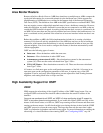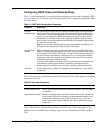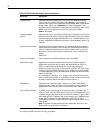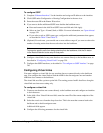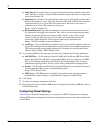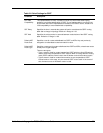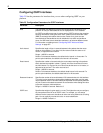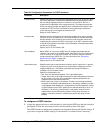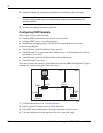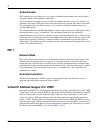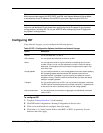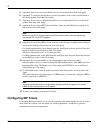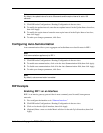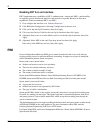
Nokia Network Voyager for IPSO 4.0 Reference Guide 363
To configure an OSPF interface
1. Assign the appropriate area to each interface by selecting the OSPF area that this interface
participates in from the Area drop-down list for the interface, then click Apply.
The OSPF interface configuration parameters are displayed showing the default settings. If
you want to accept the default settings for the interface, no further action is necessary.
Election priority Specifies the priority for becoming the designated router (DR) on this link. When
two routers attached to a network both attempt to become a designated router,
the one with the highest priority wins. If there is a current DR on the link, it
remains the DR regardless of the configured priority. This feature prevents the
DR from changing too often and applies only to a shared-media interface, such
as ethernet or FDDI. A DR is not elected on point-to-point type interfaces. A
router with priority 0 is not eligible to become the DR.
Range is 0-255. Default is 1.
Passive mode Specifies that the interface does not send hello packets, which means that the
link does not form any adjacencies. This mode enables the network associated
with the interface to be included in the intra-area route calculation rather than
redistributing the network into OSPF and having it as an ASE. In passive mode,
all interface configuration information, with the exception of the associated area
and the cost, is ignored.
Options are On or Off. Default is Off.
Virtual address Makes OSPF run only on the VRRP Virtual IP address associated with this
interface. If this router is not a VRRP master, then OSPF will not run if this option
is On. It will only run on the VRRP master. You must also configure VRRP to
accept connections to VRRP IPs. For more information, see “Configuring
Monitored-Circuit VRRP” on page 192.
Options are On or Off. Default is Off
Authorization type Specifies which type of authentication scheme to use for a given link. In general,
routers on a given link must agree on the authentication configuration to form
neighbor adjacencies. This feature guarantees that routing information is
accepted only from trusted routers.
Options for authentication are:
• Null: Does not authenticate packets. This is the default option.
• Simple: Uses a key of up to eight characters.Provides little protection because
the key is sent in the clear, and it is possible to capture packets from the
network and learn the authentication key.
• MD5: Uses a key of up to 16 characters. Provides much stronger protection,
as it does not include the authentication key in the packet. Instead, it provides
a cryptographic hash based on the configured key. The MD5 algorithm creates
a crypto checksum of an OSPF packet and an authentication key of up to 16
characters. The receiving router performs a calculation using the correct
authentication key and discards the packet if the key does not match. In
addition, a sequence number is maintained to prevent the replay of older
packets.
Table 25 Configuration Parameters for OSPF Interfaces
Parameter Description



